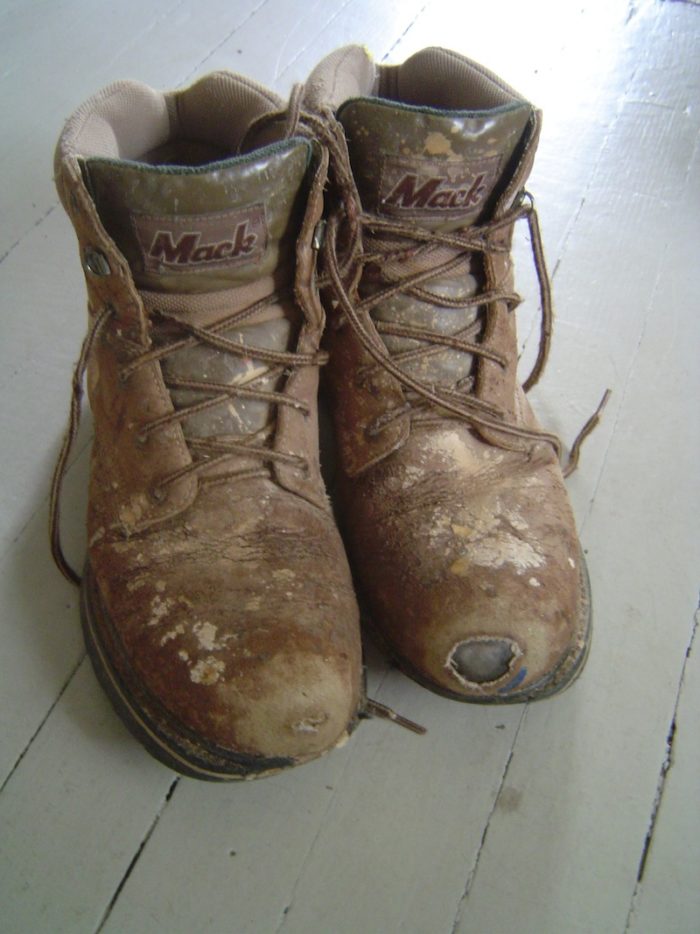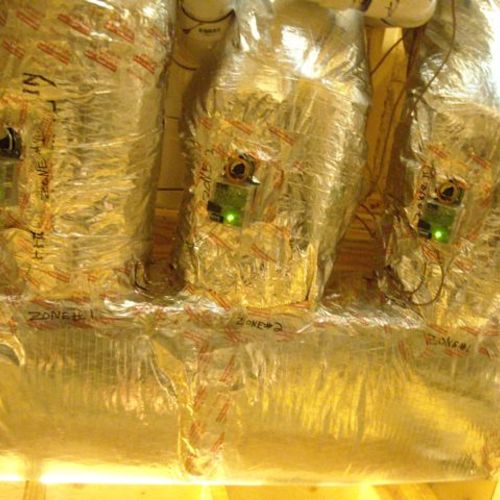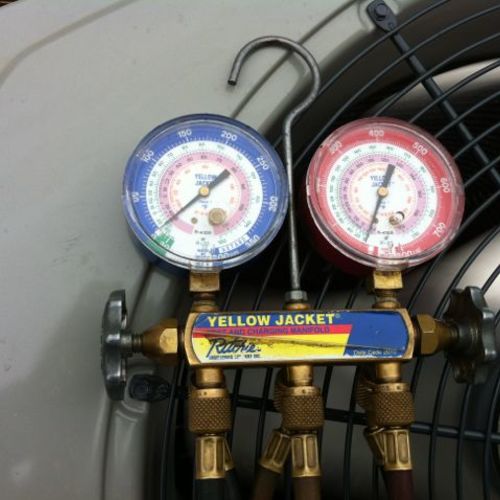Image Credit: Energy Vanguard
Image Credit: Energy Vanguard Even though this duct boot is located in a humid crawl space, it was never insulated. Notice the discoloration on the wood around the boot.
Image Credit: Energy Vanguard Condensed water dripped into this duct and collected inside the liner at a low spot. The result: a duct insulation blowout.
Image Credit: Energy Vanguard This duct boot in a new home is properly insulated. Note also that the insulation jacket was air-sealed to keep humid air away from the cold duct.
Image Credit: Energy Vanguard
I’ve seen it over and over: The central air conditioner’s ceiling registers raining down onto the floor. The insulation liner on the duct in the crawl space holding a gallon or two of water. The office that has spots appearing on the ceiling. Such problems are not at all uncommon, although they should be.
Water loves cold, you know. Cold surfaces are almost like magnets to water in its vapor form. Just think how blissfully the water vapor was floating around that one time, minding its own business, and then you sat down and put your nice cold glass of gin and tonic (or whatever cold beverage you prefer) on the table (on a coaster, of course). Within seconds, it seemed, water droplets appeared on the outside of the glass. In my part of the world (the Southeastern U.S.), it doesn’t take much longer for those droplets to become driplets.
Another place where that same phenomenon happens is on your boots. No, no, not those boots. I’m talking about your other boots, the ones you rarely look at because they’re hidden behind the registers and diffusers in your home.
Unwanted condensation
Here’s how it goes down. Air with water vapor in it can be described by several important quantities (vapor pressure, relative humidity, humidity ratio, relative fugacity…), but the one we’re interested in here is dew point.
When humid air finds a surface, such as a cold duct boot, at a temperature below the dew point, the water vapor just can’t help itself. Those water vapor molecules hurl themselves at the below-dew-point surface and stick there.
The science is pretty easy to understand. The principle is well known. And yet, I frequently see this problem of water vapor condensing where it’s not wanted.
Behold the mighty duct boot
If you have a central air conditioning system with a duct system in your home, you’ve probably got a lot of boots. Go take a look at them and see if they’re insulated. If they look like the first one you see below, where all that bare sheet metal is exposed, they’re not insulated. When cold air moves through them on the inside and humid air is sitting there on the outside, you’ve got all the ingredients for condensation.
Notice also in that photo that the wood around the uninsulated boot is discolored. That’s because the whole area stays colder. The cold boot not only attracts water vapor, it also attracts those lusty BTUs of heat, which attack the cold boot, warming the air inside it and cooling the air outside. When the wood gets colder, it absorbs water from the air. Then it starts growing nasty stuff.
Gallons of accumulating water
Back to the condensation problem, though: When enough of it starts collecting on an uninsulated boot like the one shown above, the water starts dripping down. The coaster in this case is the duct insulation, which is eager to absorb all the water that drips its way.
Once I went into a crawl space that had a couple of gallons of water in the duct insulation liner. Wow!
Those duct insulation liners are watertight…to a degree. When enough water sits in there long enough, the stress is too much. You can see the result in the second photo below. It may look wet in the photo, but it was totally dry when I was there. The blowout had happened sometime before I ever visited that house.
When this happens in a crawl space, it rarely gets discovered or recognized. Who cares if water drips down onto the already wet ground, right? Well, your duct system cares. Your bank account cares. The tadpoles care!
The ceiling is dripping
Uninsulated supply boots in a ceiling, however, usually do get noticed, at least in humid climates. Sometimes people don’t know what causes it or what to do about it, but they do notice that they’ve suddenly got spots on their ceiling where they didn’t have spots before.
The moral of this story is to insulate your boots. It’ll save you money on your energy bills and repair costs. It’ll reduce the likelihood of nasty stuff growing in your home. Moisture problems in homes are suspected to be a leading cause of asthma. It’ll make your home more comfortable, too, because the air coming out of those vents will be as cold or as warm as it’s supposed to be.
One very important detail to get right is to make sure that you use the proper materials and seal them up. If you insulate with fiberglass, it’s got to be covered with a Class I vapor retarder (i.e., a vapor barrier) to prevent water vapor from diffusing through to the cold surface. It also needs to be air-sealed to prevent humid air from leaking in and finding the cold surface.
Go on now — go look to see if your boots are insulated. You shouldn’t be able to see any sheet metal if it’s done properly, as shown in the last photo here.
Allison Bailes of Decatur, Georgia, is a RESNET-accredited energy consultant, trainer, and the author of the Energy Vanguard blog.
Weekly Newsletter
Get building science and energy efficiency advice, plus special offers, in your inbox.
















12 Comments
insulated boots
Because of their irregular shape, it's rather difficult to insulate boots and other fittings such as Y's. But I believe there exist pre-insulated boots and fittings. It would be helpful if you would list sources of those.
Can water vapor molecules really "Hurl" themselves?
Allison wrote: "Those water vapor molecules hurl themselves at the below-dew-point surface and stick there."
Is that really what happens? Can they really do that?
Do the water vapor molecules somehow sense a cold surface and somehow change direction and accelerate towards the cold surface?
I thought they were more like tiny billiard balls... bouncing around randomly and extremely fast {not exactly floating} until they encounter ANY surface...not just cold surfaces...
If the surface is cold enough .... and the water vapor molecule is appraoching at a low angle..it may "stick".
And isn't condensation happening all the time on surfaces ...warm AND cold surfaces?
Only the water is evaporating faster than it is condensing on the warmer surfaces?
Response to Charles Campbell
Yes, boots and wyes are more difficult to insulate and I'm sure there are special wraps for them. I'm not a contractor, though, so I don't know the specific products. I'm sure if you just went down to your local HVAC supply house and asked them, they'd be able to help you. (Some supply houses are snooty and won't sell anything to someone who's not a licensed contractor, but many will sell anything that doesn't specifically require the license.)
Response to John Brooks
Ah, well, if you really want to get into the details, John, let's talk about Maxwell-Boltzmann distributions and the partition function for the canonical ensemble (shown below). But we'd need to be careful because this study led Boltzmann to commit suicide, and the same end befell Ehrenfest, who took up the study afterwards.
But yes, of course, I took some poetic license with the language here, and you are indeed correct that the microscopic details are more complex. Anyone who wants to learn more about those details is advised to read a book that is a favorite of both yours and mine, Water in Buildings
crawl space help
The insulated ducts in my vented crawlspace were drenched with water along with the nearby flooring joists when I went under there a couple of years ago. My airconditioning man informed me that they could not insulate them enough to stop that and suggested installing an air circulating fan in the vent openings. After reading a newspaper article and checking a bit online I found that during the summer the crawlspace vents should be closed in houses with airconditioning ducts in the crawlspace. I closed mine and it works. The ducts were dry and so were the joists. For a nice informative pdf information on this see this website: http://www.fpl.fs.fed.us/documnts/techline/crawl_space_ventilation.pdf
Although this document suggests that the crawlspace floor and walls be covered with plastic, unfortunately mine are not but closing the vents during the airconditioning season sure did help.
Response to Russell Adams
Condensation can occur on the outside of insulated whenever the that surface is below the dew point of the air. If you live in a really humid climate with high dew points, that can happen with insulated ducts that don't have enough insulation, aren't properly sealed, or with conditioned air that's too cold in the ducts. Another great source for info about crawl space encapsulation is crawlspaces.org, Advanced Energy's page on the topic.
Raining Duct Boots & Mold
I suspect that raining duct boots & mold made several teachers seriously ill at a school in Northern PA .
Response to Allison
I really doubt that additional insulation would cure the condensation on these already insulated ducts. I live in Oklahoma which is really not a humid area but there is sufficient moisture in the air to condense on the cooler ducts. Closing the vents really did the trick as it allowed the crawlspace to cool sufficiently and stopped the warm/hot air from entering. The airconditioning contractor was way off when he recommended adding more ventilation. That would work fine if the A/C was not in use, but with those cool ducts in place... no go.
Insulating air conditioning ducts with open cell foam.
I need to insulate the floor area under a finished bedroom built over an unheated garage. The plan is to heat the loft with a radiant slab. We are using forced air with ductwork in the floor truss area to cool the loft. The floor is constructed with open web wood trusses and difficult to insulate with batts, even more challenging for the vapour barrier. The most logical solution is to use a layer of closed-cell 2 lb. foam directly under the floor and around all the ductwork, followed by more 1/2 lb. foam the achieve the desired R value. We were quoted $7000.00 to do two rooms (about 1000 sq. ft.total) and I was shocked at the price. My insulating contractor is telling me that I can save about $1500.00 by using open cell foam only because he can do the entire job in one pass. My concern is the 1/2 lb. foam is vapour permeable and my A/C ductwork will end up with condensation. He says if he sprays it on thick enough it won't be a problem. Your thoughts......?
Response to Mark Nelson
Mark,
Before attempting to tackle your question about spray foam, I want to understand your heating and cooling plan.
If I understand correctly, you plan to pour a thin concrete slab on top of your open-web floor trusses. This slab will include hydronic tubing to provide space heating for the room above.
You also plan to install forced-air ductwork between your open-web floor trusses. These ducts will be used to provide air conditioning. Do I have that right?
If my description is correct, then I conclude that your HVAC equipment and distribution system is way more complicated than necessary. If you simplify (and rationalize) your heating and cooling equipment, you can save thousands of dollars that might be spent instead on insulation improvements.
Yes, you are correct. We plan
Yes, you are correct. We plan to use an open loop geo-thermal system for cooling only and a gas boiler for hydronic heating. We opted to not depend on the geo system as our main heat source primarily due the efficiency of geo for heating and the size of the home. In this particular section of the home we have two loft rooms above workshop/ garage areas. These shop areas will only be heated to 10 celcius. Our home is located in Ottawa, Canada and I am very interested in simplfying the HVAC system if possible as long as we don't have to compromise other areas such as aesthetics, noise and comfort.
Response to Mark Nelson
Mark,
First, it seems odd to invest in an expensive ground-source heat pump system and then use it only for cooling, rather than heating and cooling. In most cases, if you are going to choose that route, it makes sense to size the system for both heating and cooling. That avoids redundant equipment.
Second, if you have decided to run ductwork to the room in question, it usually makes sense to use the ductwork for both heating and cooling, rather than to have two methods of distribution.
It may be too late to untangle this mess. But once you decided to install a ground-source heat pump, the simplest approach would have been to use the GSHP for both heating and cooling, and to distribute your warm air and your cool air through ductwork.
Log in or create an account to post a comment.
Sign up Log in